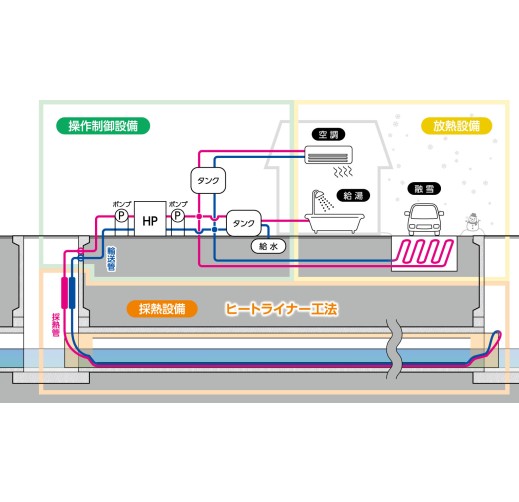Heatliner method
Technology / Service Summary
This technology utilizes the thermal energy of sewage, whose temperature is more stable than the outside air, for air conditioning, hot water supply, floor heating, and snow melting.
Purpose
Use of sewage heat energy for air conditioning, hot water supply, snow melting, etc.
This technology realizes the effective use of unused energy at the same time as the rehabilitation of sewage pipes in an aging era when sewer pipes that were installed during the period of high economic growth are due for replacement.
Feature
①Small and medium calibers can also be heat-collected.
② Stable heat collection is possible.
③ Simultaneous construction with pipeline rehabilitation can reduce construction costs.
④It is also possible to perforate the mounting pipe.
⑤ There is no odor.
⑥ Thermal energy can be used permanently.
⑦ It can also be applied to air conditioning, snow melting, etc.
Effect
Use of sewage heat energy for air conditioning, hot water supply, snow melting, etc.
This technology realizes the effective use of unused energy at the same time as the rehabilitation of sewage pipes in an aging era when sewer pipes that were installed during the period of high economic growth are due for replacement.
Controlled Substance
Reference
Applicable Regions / Countries
- Japan
Accomplishments
【Aomori】
2019 Hirosaki district No HP type (Φ250 L=39m, L=44m (melting snow 50m2))
【Niigata】
2018 B-DASH Tokamachi area 30kw research (Φ400 L=102.8m (melting snow 50m2))
【Tokyo】
2017 Kiyose area 10kw research (Φ300 L=10.0m (air conditioning 15m2))
【Nagano】
2017 Suwa area 100kw (Φ2000 L=50m (air conditioning 2000m2))
【Saga】
2018 Saga Area Research (Φ1000 L=30.0m)
Reference URL
Locations for inspection
Please contact us.
Related SDGs Goals
- 6. Clean Water and Sanitation
- 7. Affordable and Clean Energy
- 11. Sustainable Cities and Communities
- 13. Climate Action
- 14. Life Below Water



